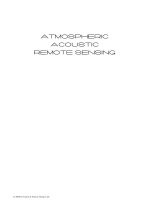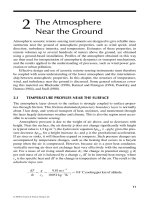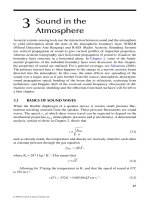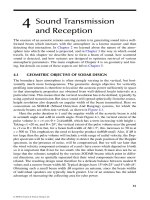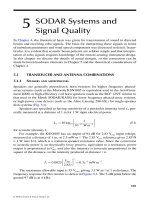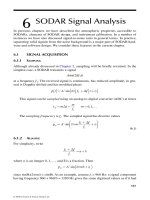Environmental Modelling with GIs and Remote Sensing - Chapter 12 (end) pdf
Bạn đang xem bản rút gọn của tài liệu. Xem và tải ngay bản đầy đủ của tài liệu tại đây (617.67 KB, 8 trang )
Environmental modelling: issues and
discussion
A.K.
Bregt,
A.K.
Skidmore
and
G.
Nieuwenhuis
12.1
INTRODUCTION
In this final chapter, problems related to the successful use of GIS and
RS
in the
domain of environmental modelling are discussed. The basis for this discussion was
a joint problem analysis by the participants and lecturers of the ITC workshop on
'Environmental modelling using GIs and remote sensing' using
a
so-called meta-
plan procedure (please see the Preface for names and affiliations of participants and
lecturers). Before presenting the joint problem analysis,
a
generic framework for
dealing with geo-related questions in environmental management was presented to
the participants. The results from the joint problem analysis are discussed below.
12.2
GEO-INFORMATION RELATED QUESTIONS IN
ENVIRONMENTAL MANAGEMENT
Environmental management, generally, requires three different kinds of
information. Firstly, the status of particular environmental indicators or variables
must be estimated. For instance, where are the most polluted sites'? Where are the
most and least productive soils'? What is the land use in a region'? Such
'whut
is
where'
questions are answered by individual surveys or observations; globally, the
number of these surveys are enormous.
The second type of geo-information of interest to researchers and land
managers is change over time. Typical questions may include: what is the change of
the forested area in southeast Asia? IIow many hectares of agricultural land were
abandoned in western Europe since
1990'?
What is the change in air pollution in the
United States in the last
10
years'? The
'what is changing where'
questions are
answered by multiple observations over a time period. Such monitoring may
involve periodically recording certain parameters at selected spots, or,
if
one is
interested in area changes,
a
full survey at regular time intervals may be necessary.
Thirdly, managers are interested in projections, both spatially and temporally;
such projections may be characterized by
'wlzat will be where'
questions. For
example: what will happen with the environmental pollution if we implement
measure
A?
What will be the effect of urbanization on nature development in
densely populated areas'? Of the three types of questions, the
'what will
be
where'
type is most difficult to answer. Besides an initial state of the land use (the
'what is
where'
question), an understanding of the process of change as well as the
interaction between factors is required. This is extremely difficult, especially when
Copyright 2002 Andrew Skidmore
Environmental modelling: issues and discussion
253
biophysical and social-economical processes are considered together. In practice
we see that it impossible to answer the question
'what will be where'
with great
precision. Instead of a crisp prediction, we see the development of scenario's that
represents possible lines of development.
In Table 12.1 the requirements in terms of data and processes of the three
types of questions are indicated.
Table
12.1:
Requirements for different questions.
Question Data Models Techniques
What is where?
Spatial data Model for spatial data Standard DBMS and
GIs
What is changing
Spatial data at time
Model for space-time Standard DBMS and
where? intervals
data
GIs
What will be where? Spatial data at time
Model for space-time
GIs, modelling
intervals data environments and
Model for projection frameworks
Geo-spatial tools required for the analyses in Table 12.1 may be defined. For
example, the
'what is where'
question requires a geographic information system
(GIs)
to store spatial data and make simple (Boolean) enquiries. The main
constraints with this type of analysis lie in the domain of data access and data
accuracy. For the
'what is changed where'
questions, multiple observations of land
cover are required. Remote sensing techniques seem attractive for monitoring, but
inaccurate classification, especially when compounded over time, may lead to
unacceptably low accuracies. The analysis techniques available in
GIs for
analyzing spatial time series are also limited (Bregt and
Bulens 1998). Methods
need to be developed to survey, manage and analyze spatial data over time. Finally,
for the
'what will be where'
questions, a combination of data, representing the
initial status, and some rules or models describing the change of the environment
over time, are needed. These rules range from relatively simple expert tables
describing change in discrete intervals over time to complex dynamic simulation
models describing change at continuous time intervals (see Chapter 2). It should be
noted that the more complex dynamic simulation models are usually deductive, for
example describing physical or chemical processes, such as the transport of water
or the acidification of the soil (see Chapters 2 and 9). For exploring the
'what will
be where'
question, data and transformation rules are combined in what is often
called a spatial decision support system (SDSS) (see also Chapter 11). These
systems generally consist of a standard
GIs with some additional software
components to facilitate decision support.
Copyright 2002 Andrew Skidmore
254
Environmental Modelling
with
GIS and Remote Sensing
12.3 PROBLEMS RAISED
BY
THE PARTICIPANTS
At the end of the course, participants and lecturers discussed problems encountered
in the practice of environmental management using
GIs and remote sensing. This
discussion was structured using a so-called meta-plan procedure. According to this
procedure all the participants were asked to write, on separate pieces of paper,
problems related to the topic of the course. Subsequently, all the problems raised
were discussed and grouped into four main categories. In total
56
problems were
mentioned. In Table 12.2 the main categories are presented.
Table
12.2:
Main problems in the field
of
environmental modelling.
Main problem Times mentioned Percentage
Data
27
48
Modelling 13
23
GIS
and
RS
technology 10 18
Expertise
6
11
Participants mentioned the issue of data for environmental modelling as being most
problematic (see Chapters 3 and
4).
The technology and the lack of expertise are
considered to be minor problems, perhaps indicating that the technology and the
development of appropriate skills are reaching a stage of maturity. Let us now have
a closer look at the issues within the main problem categories.
12.3.1 Data
problems
Within the data problem category the following issues were mentioned (note that
the number of responses for each issue is in brackets):
Lack of data and gaps in data coverage (spatial and temporal) (8)
Accuracy and error propagation
(7)
Data costs (3)
Data incompatibility (2)
Data sharing
Lack of common format of data
Data collection
Implementation of remote sensing observations in models.
Many practical problems are encountered with data in
GIs modelling. Firstly, there
is a lack of data, while data sets (spatial and temporal) frequently have gaps. If data
are available, then accuracy may be insufficient to answer questions. Secondly, the
cost of data is high reflecting the fact that field observations and mapping are time
consuming and therefore expensive. Thirdly, there is hardly any programme
focused on the systematic collection of spatial data to monitor the earth system; this
problem is compounded by data from different sources often being incompatible
(e.g. different scales, different classification systems being used in legends etc.), a
problem discussed in Chapter 8. Remote sensing observations cannot be directly
Copyright 2002 Andrew Skidmore
Environmental modelling: issues and discussion
255
used in models. To convert radiation intensities into relevant parameters requires
additional research. In general, data are scattered, incomplete, of variable quality
and poorly documented.
12.3.2 Modelling problems
Within the modelling problem category the following issues were mentioned during
the meta-plan procedure:
Merging of data; scaling problems
(5)
Validation of models (2)
Models: not good enough
Incorporation of dynamic models in GIS
Schematization of the complex real world
Too much modelling and too little analytical work
Developing models.
The participants and lecturers have clearly considered modelling in its widest
sense; both the modelling of dynamic spatial processes as well as data modelling
per
se.
The modelling and integration of data collected at different scales is
considered to be a most important problem (see also Section 12.3.1). The
validation of models is mentioned twice
-
there is clearly overlap with the problem
of the quality of input data mentioned in the data problem section above. It was felt
that the models are still not good enough, for example in the areas of dynamic
modelling and dealing with the real world. During the course, and this book, it is
shown that environmental models are useful for scenario studies on the state of the
environment, and numerous models have been demonstrated (for example, see
Chapter 2). The correct use of models requires, however, high quality models, in-
depth knowledge of the
model(s) being used, as well as systematically collected
input data.
12.3.3
GIS
and remote sensing technology problems
Within the technology problem domain the following issues were mentioned:
Handling of remote sensing images from new sensors (e.g. hyperspectral, high
spatial resolution, radar)
(4)
Remote sensing image interpretation (3)
User-friendly GIs and remote sensing packages and specific software tools (2).
There are commercial systems available for GIS and remote sensing image
processing as well as low budget systems with a remarkable functionality.
Nevertheless, remote sensing image processing still requires specific software and
hardware to be able to process data over large areas and to handle the new types of
remote sensing data (see Chapter 3). The participants felt that remote sensing image
interpretation is still a problem; this perhaps partly reflects the fact that the course
Copyright 2002 Andrew Skidmore
256
Environmental Modelling
with
CIS and Remote Sensing
focussed on GIs modelling, and not remote sensing
per
se.
However, it is clear that
the software for handling remote sensing images requires specific knowledge and is
perceived as not being user-friendly.
12.3.4 Expertise problems
Within the expertise problem domain the following issues were mentioned:
Integrated knowledge about GIs, RS and modelling
GISRS; too far from user
Cross-disciplinary work
Practical know-how
Lack of expertise
Lack of trained persons.
Within the broad problem field of 'expertise', no single issue emerged. Topics
mentioned may be broadly grouped as how to combine
GIs and remote sensing
technologies, enable inter-disciplinary work, and overcome a shortage of expertise.
12.4
PROPOSED SOLUTIONS FOR PROBLEMS BY PARTICIPANTS
The participants were then asked to indicate solutions for the problems mentioned
in Section 12.3. The same procedure was followed: individual solutions written on
paper were submitted to the session coordinators, and this was followed by
a
discussion among the participants and lecturers.
In total, 30 solutions were suggested. In Table 12.3, the groupings under the
main problem categories are presented.
A
new category (General) was added for
solutions that did not apparently fall under one of the main problem categories.
Table
12.3:
Number of solutions for the main problem categories.
Main problem Number of solutions Percentage
Data 15 50
Modelling
5
CIS and RS technology
3
Expertise
3
General
4
Most of the solutions presented by the participants were given for the data problem
(50
per cent). Let us now have a closer look at the suggested solutions.
12.4.1 Data solutions
The following solutions were suggested for the data problem (note that the number
of responses for each issue is in brackets):
Copyright 2002 Andrew Skidmore
Environmental modelling: issues and discussion
Improved spatial and temporal resolution of RS
(4)
Standardization of spatial data (2)
Lower the cost of data (2)
Global climate database
Global data accessibility network
Development of data infrastructures and metadata
Data warehouse
More databases
Common data format
More ground observations.
The number of satellite systems is increasing, especially with commercial operators
entering the market (see Chapter 3). The participants and lecturers expected high
resolution imagery to be most useful for environmental modelling. Most of the
other solutions suggest improved methods to store and distribute spatial data, for
instance by using standardized databases that are easily accessible via the Internet.
The development of spatial data infrastructures and easy accessible (global) spatial
databases at low cost were considered to be the main solutions for the data
problem.
12.4.2 Modelling solutions
The participants and lecturers suggested that the following ideas and developments
would assist in solving some of the problems inherent in models:
Better translation of models to applications
More focussed models which deal with specific applications
Development of new models
Improved image processing models to insert remote sensing data into GIs
Increased use of GIs in environmental and resource modelling and planning.
In summary, it was felt models that are better focused towards specific applications
are required, both in the area of
GIs as well as remote sensing.
12.4.3
GIs
and
RS
technology solutions
It was noted above (Section 12.3.3) that technology was not considered a major
constraint by the participants and lecturers. Indeed, the focus was on the integration
of data from new remote sensing systems into
GIs models. The following two
points were made by the course participants
More research on remote sensing data quality improvement (2)
New sensors.
Copyright 2002 Andrew Skidmore
258
Environmental Modelling with
GIs
and Remote Sensing
Solutions were expected from the use of new sensors and further research in the
field of remote sensing data quality. Surprisingly, no solutions were mentioned in
the field of faster hardware, though better software was implicit in the comments
for improved modelling solutions. Apparently, the current
GIs and remote sensing
technology is fast and user-friendly enough to support users.
12.4.4 Expertise solutions
The following solutions were suggested to relieve the expertise problem:
More GIs and remote sensing education
Practical courses in GIs and RS
*
Inter-disciplinary work.
A
simple conclusion is that the main solution to the expertise problem is education,
with an emphasis on a multi-disciplinary approach.
12.4.5 General solutions
We grouped the following solutions presented by the participants and lecturers
under a 'general' category as no consistent theme was apparent:
Increased public awareness
Development of applications with users
Better products for end users
Mobile GISIRSIGPS systems (hand-held).
Perhaps the general solutions can be best summarized as improved communication.
The communication with end users and the general public was considered an
important missing element in
GIs modelling. The need to develop portable mobile
systems may also be perceived as a solution to the communication problem.
12.5 REFLECTION
Perhaps the most interesting result is that the problems perceived with GIs
modelling for environmental applications, that is data and models, has not changed
in the last decade. At the First International Conference on Integrating
GIs and
Environmental Modelling held in Boulder Colorado, during September 199 1, a
similar list of problems emerged (Crane and Goodchild 1993). This summary
highlighted systems issues
(i.e. open architecture for model development, as well as
systems benchmarking), data issues,
GIs tools issues (i.e. tools fell short of what
users require), and finally that a taxonomic catalogue of environmental models was
required in order to better understand each model's value and its ability to interface
with
GIs (Crane and Goodchild 1993). In contrast, 15 years ago the main problem
perceived in implementing
GIs was hardware (Croswell and Clark 1988).
Copyright 2002 Andrew Skidmore
Environmental modelling: issue
v
and di.rt.u.r sion
259
The lack of progress could be because our scientific knowledge of the Earth
system accumulates at an agonizingly slow pace (Crane and Goodchild 1993), or
perhaps it is because as human nature strives for knowledge, the perception is that
progress is glacial. Certainly there is continuing progress in many areas of GIs
applied to environmental modelling. We hope this book contributes in a small way
to knowledge, and stimulates further research, demonstration and operation of GIs
for environmental modelling.
12.6
REFERENCES
Bregt, A.K. and Bulens
J.D.,
1998, Integrating GIs and process models for land
resource planning. In Heineke,
H.J.,
Eckelmann,
W.,
Thomasson, A.J., Jones,
R.J.A., Montanarella, L.B., Buckley, B. (eds.). Land information systems:
developments for planning the sustainable use of land resources. European Soil
Bureau Research Report no. 4,293-304.
Crane, M.P. and Goodchild,M.F., 1993, Epilog. In Goodchild,
M.F.,
Parks, B.O.,
Steyart,
L.T.
(eds.).
Etzvironmental modeling with CIS.
New York, Oxford
University Press, 481-483.
Croswell, P.L. and Clark, S.R., 1988, Trends in automated mapping and geographic
system hardware.
Photogranzmetric Engineering and Remote Sensing,
54,
1571-1576.
Copyright 2002 Andrew Skidmore


